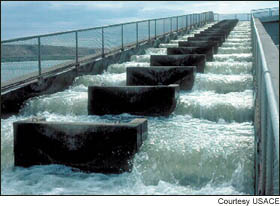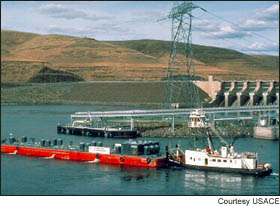forum
library
tutorial
contact

Salmon, Energy or Potatoes?
by Margot HigginsEnvironmental News Network, March 27, 2001
|
the film forum library tutorial contact |

|
Salmon, Energy or Potatoes?by Margot HigginsEnvironmental News Network, March 27, 2001 |
 Despite a severe drought and a
shortage of power in the Pacific
Northwest, keeping the lights on for
people does not have to mean
turning the lights out for salmon,
conservation groups say.
Despite a severe drought and a
shortage of power in the Pacific
Northwest, keeping the lights on for
people does not have to mean
turning the lights out for salmon,
conservation groups say.
In recent weeks federal agencies have released an emergency plan for the region which includes cutting back several key salmon protection measures in order to increase electricity produced by federal hydro-electric dams on the Columbia and Snake rivers.
This means that critical parts of the federal recovery plan for salmon, outlined in a biological opinion last summer, will not be implemented.
Elements of the federal salmon recovery plan that federal agencies propose to waive this year include increasing spring and summer river flows and spilling water over the dams to assist migrating salmon on their journey to the ocean.
As a result of second lowest snowpack ever recorded, the 2001 salmon migration on the Columbia and Snake Rivers is already predicted to be one of the most fatal on record for salmon.
Scientists from the Northwest Power Planning Council estimate that eliminating spills altogether could decrease the survival rate of ocean-bound young salmon and steelhead by 1.6 percent to 6.5 percent, depending on the species. But conservation groups and state and tribal biologists predict the number will be much higher.
Environmentalists have strongly argued for the removal of the four lower Snake River dams as the best way to recover endangered salmon and steelhead populations. If the dams are not removed, they say, river flows will need to be increased by tapping upper river reservoirs that are normally used to store water for irrigation.
 Instead of aquiring additional
water to improve river conditions,
the agencies have proposed to
barge and truck downstream as
many salmon as possible.
Instead of aquiring additional
water to improve river conditions,
the agencies have proposed to
barge and truck downstream as
many salmon as possible.
Eighty-five percent of endangered Snake River salmon and steelhead smolts were artificially transported by the U.S. Army Corps of Engineers during the 2000 migration season, conservation groups note. Under the new federal plan, that total this year could be 95 percent.
Environmentalists cite a February 1998 report by the Independent Scientific Advisory Board, which oversees Columbia River basin salmon recovery efforts. The board criticized the Army Corps for barging the vast majority of young salmon. "It is impossible to reconcile a maximum transport approach to salmon recovery with protection of the remaining diversity of salmon and steelhead populations in the Snake River basin," the report concluded.
"This is just the sort of train wreck we warned would occur if we left the dams in and had a severe drought," said Scott Bosse, a biologist with Idaho Rivers United. "Now that itís here, the federal action agencies are reacting like a deer caught in the headlights."
With dam removal out of the picture for the next several years, fishing and conservation groups are asking Congress to support an operations plan on the Columbia and Snake rivers that would improve river conditions for endangered salmon without reducing power generation.
The plan calls for additional water from upper river storage reservoirs to aid in fish migration and to increase flows that could be used to generate power during the current emergency. A portion of the revenue from the power sales would be used to compensate farmers that normally use the reservoirs to irrigate their crops.
"There is a significant amount of water that could be pushed through the system that the feds are not even considering," said Shawn Cantrell of Friends of the Earth.
About 1 million acre feet of water could come from the upper Snake River reservoirs and reservoirs on the middle Snake at Hells Canyon.
The idea is not likely to find favor with Idaho potato growers, who depend on the reservoirs to meet irrigation needs. But their argument may be less compelling in the midst of the current potato surplus.
In the hope of boosting potato prices, which now fall below the cost of production, Idaho growers have removed loads of fresh potatoes from the market.
"It doesn't make sense to grow surplus crops in a year when water is more valuable for power and fish generation," Cantrell said. "Even under the best circumstances, fish energy and agriculture will all be hit hard this year. We're trying to find a more equitable distribution because right now the fish are getting hit the hardest."
learn more on topics covered in the film
see the video
read the script
learn the songs
discussion forum
